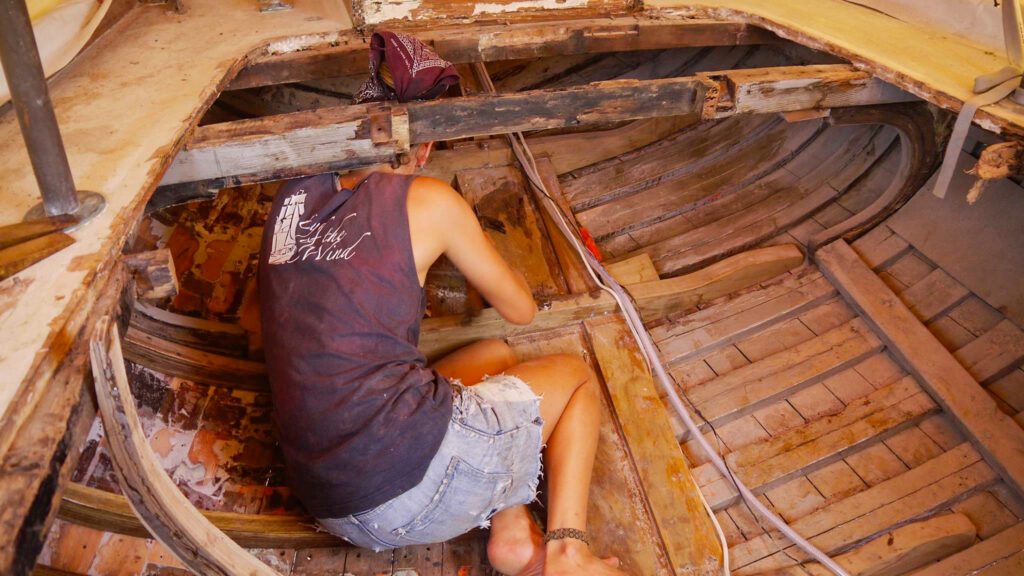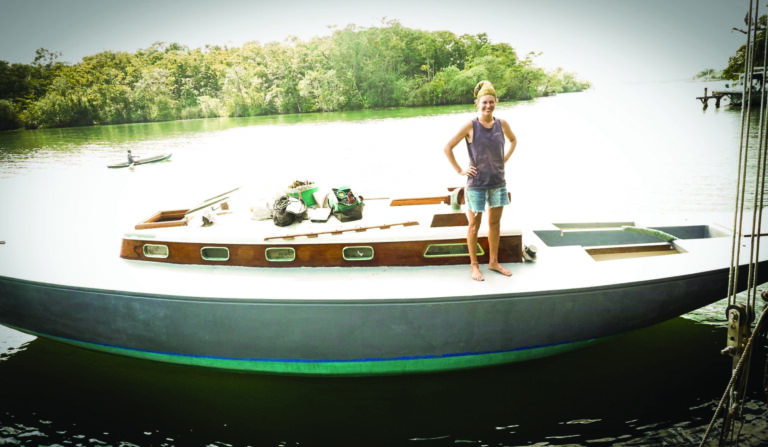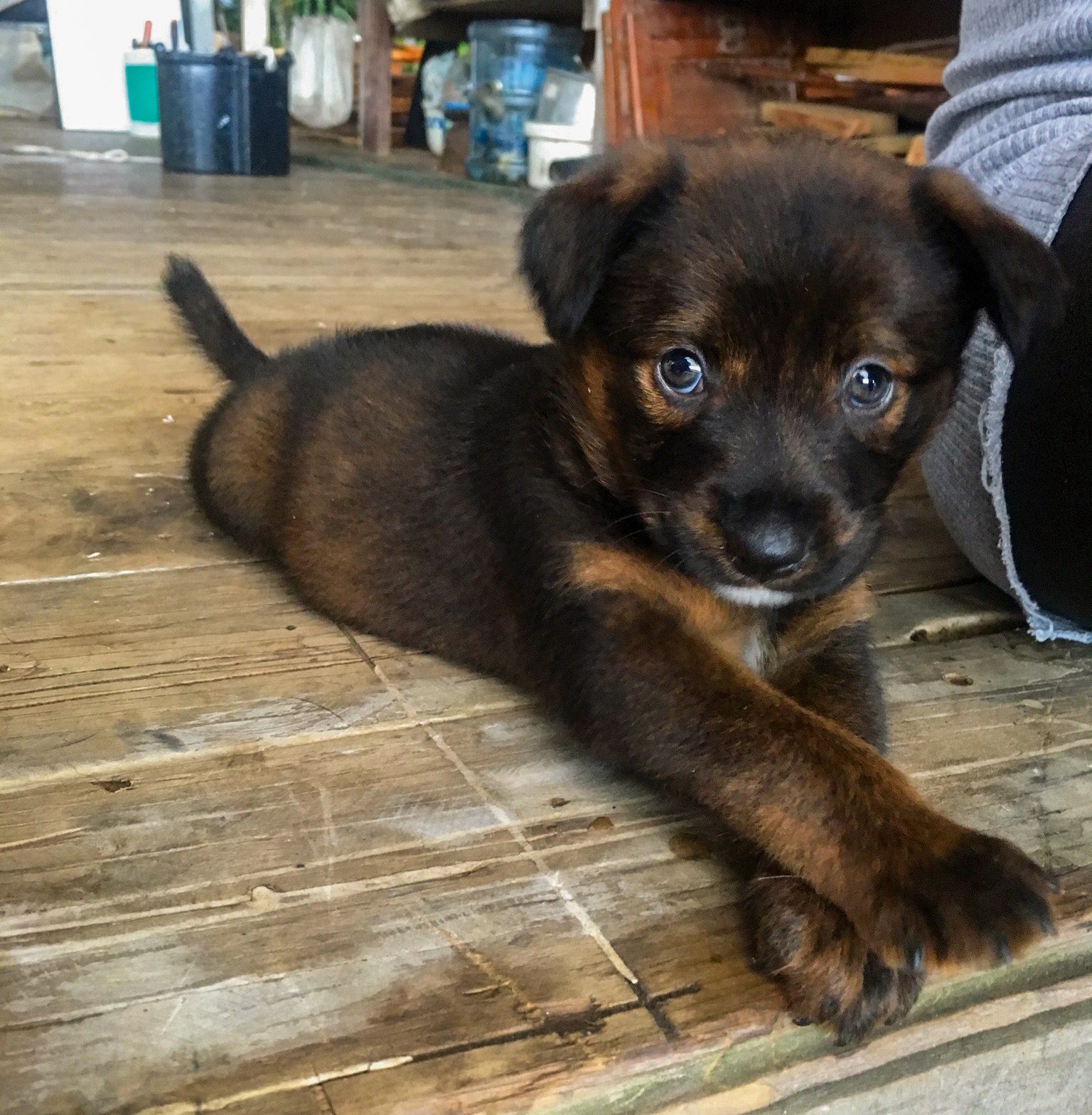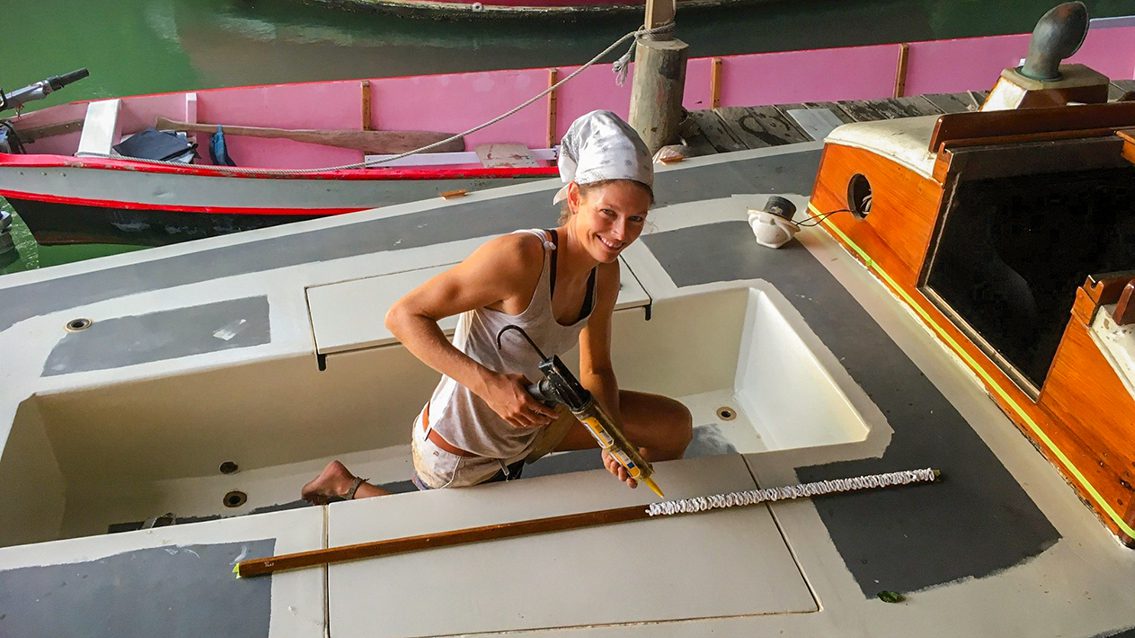
By Robin Stout | Fall 2023 Issue
We met Sarah Schelbert in Antigua 2022 when she sailed her boat into the harbor with her dog and asked if she could race in the Classic Regatta.
She turned out to be the life of the party. The next year Sarah sailed into Antigua to race the Classic Regatta and seemed so much more sure of herself and had a crew. We know that we want to get to know her better.
Robin: Sarah, please tell us a little about yourself and your boat. Tell us why you want to live this lifestyle and any suggestions you’d give to others considering something similar?

Sarah: I’m Sarah, 34 years old, born in Germany. Until I was 25 I didn’t set foot on a sailboat, as sailing was just not a thing in southern Germany. I was always into traveling and loved the ocean and I was very much into surfing from my late teens. I studied German Literature and Political Science and have a Bachelor of Arts. I was always the smart kid, never really hands on.
After Finishing my Bachelors Degree I wanted to travel to Central America. Some friends told me about the possibility of “boat hitchhiking” across the Atlantic and so I went to the Canary Islands to find a boat. Never having sailed before I thought this would be a great adventure and a good way of slow traveling with less carbon footprint. I saw it as a means to get to the other side, not really something I would want to pursue. However, during the crossing I of course got intrigued by it and after reaching Grenada, I started crewing on different boats. My goal was to get to Panama. I couldn’t find a boat, but met a handsome young guy from Nova Scotia with his beautiful Herrenshoffe H28 design. We started sailing together and on his boat “Lizzy Belle” is really when I learned how to sail. I sailed all the way to Guatemala with him and then did some traveling and backpacking there. We spent two seasons together sailing Lizzy Belle in the Caribbean in winter and doing other boat stuff in Nova Scotia in the summer. I learned quickly and loved the simplicity and the closeness to nature and the elements that sailing life brings with it.
After a painful breakup I found myself back in rainy Germany and thought the time might have come to start a “real” life, get a job, buy a house etc, etc. But after four months I knew that I wasn’t made for it anymore and needed to go back to the ocean. So I found a volunteer position on a Square Rigger, the “Eye of the Wind” for two months in the Caribbean, sailing back through a lot of the places I knew already.
Still kinda heart broken, I was now looking for a project, something more than just floating around backpacking. The opportunity presented itself when after leaving the Eye of the Wind, I stopped in Guatemala to visit some friends. There was this gorgeous wooden boat sighted in the bat and the owner said we wanted to sell her as he felt too old to keep up with the maintenance. My friends urged me “this is your boat Sarah.” I was sure that I was hugely lacking experience (I had only really sailed for about 2.5 years at that point) and also was still on a backpackers budget! But, it was meant to be and a couple of weeks later I signed the contract and was now proud owner of Alani. My “new boat” was a 35 ft wooden Gunnery Sloop built in 1960 and needed more work than I realized.

In the weeks to come I found out she was in much worse shape that I thought. She was taking on lots of water and the stern post was soft and rotten. There were no wooden boat shipwrights in the Rio Dulce at the time and so I sailed her up to Sarteneja in Belize, where traditional wooden boat building culture is still very much alive. One of the shipwrights assure me he could fix the problem and so we took on the challenge trying to figure out how to haul Alani out on the beach in Sarteneja. traditionally, boats are just laid on their side and pulled out of the water on palm tree rollers. With Alani’s deep keel and fragile rib cage, that wasn’t an option for me. So we built a cradle to pull her out of the water upright. No one had ever done this in Sarteneja but everyone seemed confident. The whole endeavor failed completely, due to too much friction and the soft mud was too deep. We got her half way out of the water before I pulled the plug and realized this wasn’t working.
So I started my journey back to Rio Dulce. on the way, the head gasket of my old Westerbeke engine blew. I arrived back with a boat more broken than before, no more engine and completely out of money. That was the time lots of my friends advised me to just let it go, I didn’t have the money or experience to fix her up and should just go back to Germany, earn some money and buy another boat. I cried for a couple of days and then decided f*** it! If wqwl can’t find anyone to fix her, I’ll just have to do it myself. So I bought some books, some old tools, hauled her out and started the process. I had huge support from my parents, friends, especially from my very good friend Tom, who had a sail repair shop and knew a lot about how to fix things. A couple of weeks later I found a job with a charter company in Belize called “Belize Sailing Vacation” which was to finance my whole refit. So I spent three years between charter jobs in Belize and months in the boatyard and later working on Alani at Toms shop.

I started by stripping the hull down to bar wood and ripping the cockpit out to access the rotten stern post. Rebuilding the stern post and part of the horn timber was the first huge challenge. With almost no wood working experience it took a lot of sweat, tears, frustration and time to figure out what I had to do. Fortunately, I had some great wooden boat folks right close by in the yard providing lots of advice and encouragement and several friends who helped when I needed them.

After the stern post I started laminating frames to repair and fix all the missing/broken ones on board. Then followed plank repairs. After all that we glassed her over with two to three layers of fiberglass. She was splashed, then I rebuilt the cockpit, repaired the deck, re-glassed the deck, rebuilt the cockpit combings and made a new toe rail. Put all the interior back in, installed a new Beta Marine 25 engine, put the mast back on with a complete new rig, installed new bronze chain plates (we bent and fitted them ourselves) and a bunch of more stuff.
When she was finally ready to sail in November 2019, I took off on my first ever offshore passage as a captain and with the help of friends, and sometimes solo, sailed her across the West Indies. I had picked up Maya as a puppy before I left.
We got locked down in Dominica during Covid and my brother, who was sailing with me at the time, decided to stay there when i took off to Grenada for hurricane season. In Grenada I met Chris and Chrystal from LTD Sailing and started working for their sailing school as a sailing instructor. I had been certified during my captaining in Belize as a sailing instructor and had done classes there already. I loved Carriacou from hen I first anchored there and made that the home of my choice. I now have my own company “Schelbert Marine,” doing captaining, deliveries, woodwork, general boat yard work and still teaching sailing for LTD.

I love living aboard with Maya, without her on board I probably wouldn’t have made it in many moments. Solosailing Alani was and still is a pretty big challenge as the navigation setup is simple (self-steering wind vane is my only autopilot), she heels hard and the cockpit is not made for comfort.
I took part in the Carriacou Regatta in 2021 and since then the Regatta bug bit me. I upgraded her with a set of new sails and some bigger winches and am determined to perfect to sail her as best as she and I can.
I am currently not planning on leaving Grenada/Carriacou anytime soon. I would love to get involved in building a Carriacou sloop, as I’m fascinated by this tradition. During the time owning Alani I just learned not to make too many plans far into the future, but to be open and flexible to what life presents. I’d love to do more woodwork, encourage more women sailing and more racing. My brother lives in Dominica and I really like spending time there as well.
The advice I would give for anyone who wants to live aboard is not to be scared. Even if the challenge seems huge at the beginning, you will learn quickly and anyone can do it if the will and determination are there. My personal advice would also be to keep your boat setup as simple as possible so you don’t get overwhelmed by too many (non-crucial) items and appliances that need maintenance and fixing. This lifestyle is, after all, about living simply, being out in nature, connected to the elements, the people and culture around you and being connected to yourself.
You can follow Sarah and her adventures at: @wood_watter_and_i or www.woodwaterandi.com

